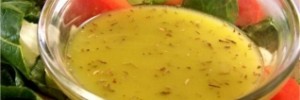Category for Cooking Tips
The most common dressing for salad is vinaigrette. A vinaigrette is acid and oil, combined; every other addition is up for grabs. The acid may be freshly squeezed citrus juice, usually lemon or lime, or vinegar — the best you can find. The acidic ingredient is the most basic flavor of a vinaigrette, so it […]
Read the rest of this entry »Like oil, there are several types of vinegars. There is chemically produced, distilled vinegar, the familiar, extremely inexpensive “white” vinegar. If you want nothing more than a clean, sour flavor, you could do worse than this. But acidity is only part of the reason to use vinegar (or lemon juice): good flavor is the other. […]
Read the rest of this entry »Edible oils are made from nuts (such as walnut), seeds (such as sesame and cotton), vegetables (such as corn), legumes (such as soy), and fruits (such as olive). But in actual fact, they all fall into just three categories: neutral, all-purpose, and highly flavorful. Neutral Oils: For Cooking Only Neutral oils add little or no […]
Read the rest of this entry »The wok’s versatility obviates the need for a battery of utensils for different methods of cookery, but it is helpful to have two woks, of 25 cm (10 inches) and 35 cm (14 inches) diameter. The larger one is better for holding bamboo steamers and for smoking, while the smaller wok can be used for […]
Read the rest of this entry »The various types of cooking pots used in Chinese kitchen While the wok reigns supreme in every Chinese kitchen, stir-frying is by no means the only cooking method; one-pot dishes are common among rural Chinese families in colder regions. Various types of cooking pot play important roles in preparing stocks, stews and braised dishes. A […]
Read the rest of this entry »Steaming with different types of steamer The culinary technique of steaming food is steeped in yin-yang philosophy. In China, the belief is that fried foods must be counteracted by those that contain less or no oil, and are therefore healthier. Steaming food with steamer uses minimal amounts of flavorings, allowing the natural flavors of the […]
Read the rest of this entry »Considering fat when cooking stock There are two special “techniques” for stock that concern fat. The first is really more something to remember than to learn: Never allow stocks or soup to boil vigorously. This is a generalization; there are times it will do no harm at all. But once fat is rendered by the […]
Read the rest of this entry »Pureeing soup The advent of the blender (including the handheld immersion blender) has made it possible to puree almost any vegetable soup, and many others as well. (As it happens, however, a hand-cranked food mill is usually just as easy.) Thicken purees if you like, stir in some cream, milk, half-and-half, yogurt, sour cream, or […]
Read the rest of this entry »Preparing foods for soup If you are going to puree vegetables to thicken soup or to make a creamy soup, it doesn’t matter much how you cut them. It does, however, help to cut them to about the same size so they all finish cooking at the same time. If, however, you’re going to leave […]
Read the rest of this entry »The two different types of rice There are essentially two kinds of rice: long and short grain. (Technically, almost all rice is Oryza sativa and, within that species, there are 0. sativa indica, long grain, and 0. sativa japonica, short grain.) But within each of those categories are many, many varieties (probably forty thousand or […]
Read the rest of this entry »